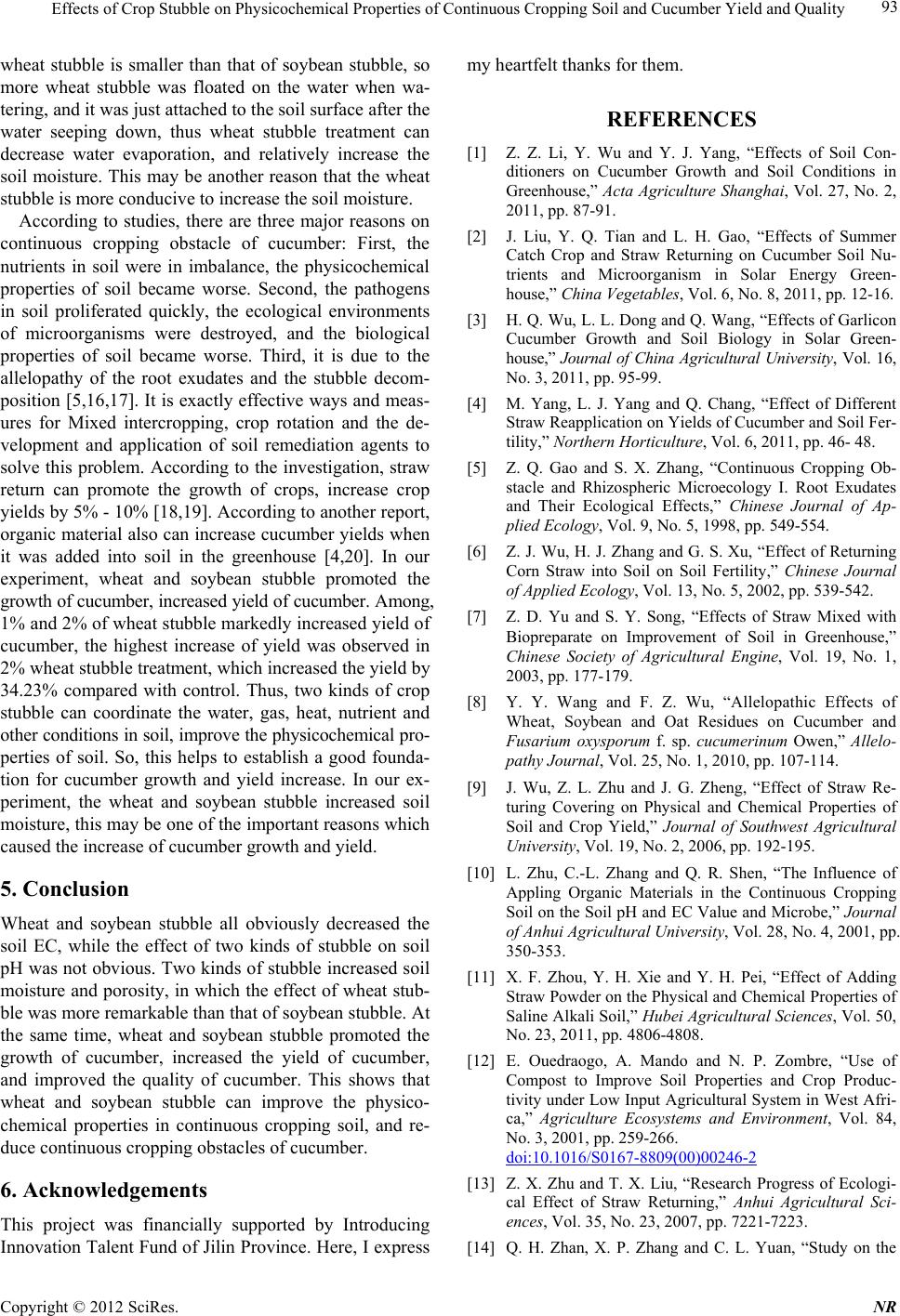
Effects of Crop Stubble on Physicochemical Properties of Continuous Cropping Soil and Cucumber Yield and Quality 93
wheat stubble is smaller than that of soybean stubble, so
more wheat stubble was floated on the water when wa-
tering, and it was just attached to the soil surface after the
water seeping down, thus wheat stubble treatment can
decrease water evaporation, and relatively increase the
soil moisture. This may be another reason that the wheat
stubble is more conducive to increase the soil moisture.
According to studies, there are three major reasons on
continuous cropping obstacle of cucumber: First, the
nutrients in soil were in imbalance, the physicochemical
properties of soil became worse. Second, the pathogens
in soil proliferated quickly, the ecological environments
of microorganisms were destroyed, and the biological
properties of soil became worse. Third, it is due to the
allelopathy of the root exudates and the stubble decom-
position [5,16,17 ]. It is exactly effective ways and meas-
ures for Mixed intercropping, crop rotation and the de-
velopment and application of soil remediation agents to
solve this problem. According to the investigation, straw
return can promote the growth of crops, increase crop
yields by 5% - 10% [18,19]. According to another report,
organic material also can increase cucumber yields when
it was added into soil in the greenhouse [4,20]. In our
experiment, wheat and soybean stubble promoted the
growth of cucumber, increased yield of cucumber. Among,
1% and 2% of wheat stubble markedly increased yield of
cucumber, the highest increase of yield was observed in
2% wheat stubble treatment, which increased the yield by
34.23% compared with control. Thus, two kinds of crop
stubble can coordinate the water, gas, heat, nutrient and
other condition s in soil, impro ve the physicoche mical pro-
perties of soil. So, this helps to establish a good founda-
tion for cucumber growth and yield increase. In our ex-
periment, the wheat and soybean stubble increased soil
moisture, this may be one of the important reasons wh ich
caused the increase of cucumber growth and yield.
5. Conclusion
Wheat and soybean stubble all obviously decreased the
soil EC, while the effect of two kinds of stubble on soil
pH was not obvious. Two kinds of stubble increased soil
moisture and porosity, in which th e effect of wheat stub-
ble was more remarkable than that of soybean stubble. At
the same time, wheat and soybean stubble promoted the
growth of cucumber, increased the yield of cucumber,
and improved the quality of cucumber. This shows that
wheat and soybean stubble can improve the physico-
chemical properties in continuous cropping soil, and re-
duce continuous cropping obstacles of cucumber.
6. Acknowledgements
This project was financially supported by Introducing
Innovation Talent Fund of Jilin Province. Here, I express
my heartfelt thanks for them.
REFERENCES
[1] Z. Z. Li, Y. Wu and Y. J. Yang, “Effects of Soil Con-
ditioners on Cucumber Growth and Soil Conditions in
Greenhouse,” Acta Agriculture Shanghai, Vol. 27, No. 2,
2011, pp. 87-91.
[2] J. Liu, Y. Q. Tian and L. H. Gao, “Effects of Summer
Catch Crop and Straw Returning on Cucumber Soil Nu-
trients and Microorganism in Solar Energy Green-
house,” China Vegetables, Vol. 6, No. 8, 2011, pp. 12-16.
[3] H. Q. Wu, L. L. Dong and Q. Wang, “Effects of Garlicon
Cucumber Growth and Soil Biology in Solar Green-
house,” Journal of China Agricultural University, Vol. 16,
No. 3, 2011, pp. 95-99.
[4] M. Yang, L. J. Yang and Q. Chang, “Effect of Different
Straw Reapplication on Yields of Cucumber and Soil Fer-
tility,” Northern Horticulture, Vol. 6, 2011, pp. 46- 48.
[5] Z. Q. Gao and S. X. Zhang, “Continuous Cropping Ob-
stacle and Rhizospheric Microecology I. Root Exudates
and Their Ecological Effects,” Chinese Journal of Ap-
plied Ecol ogy, Vol. 9, No. 5, 1998, pp. 549-554.
[6] Z. J. Wu, H. J. Zhang and G. S. Xu, “Effect of Returning
Corn Straw into Soil on Soil Fertility,” Chinese Journal
of Ap plied Ecology, Vol. 13, No. 5, 2002, pp. 539-542.
[7] Z. D. Yu and S. Y. Song, “Effects of Straw Mixed with
Biopreparate on Improvement of Soil in Greenhouse,”
Chinese Society of Agricultural Engine, Vol. 19, No. 1,
2003, pp. 177-179.
[8] Y. Y. Wang and F. Z. Wu, “Allelopathic Effects of
Wheat, Soybean and Oat Residues on Cucumber and
Fusarium oxysporum f. sp. cucumerinum Owen,” Allelo-
pathy Journal, Vol. 25, No. 1, 2010, pp. 107-114.
[9] J. Wu, Z. L. Zhu and J. G. Zheng, “Effect of Straw Re-
turing Covering on Physical and Chemical Properties of
Soil and Crop Yield,” Journal of Southwest Agricultural
University, Vol. 19, No. 2, 2006, pp. 192-195.
[10] L. Zhu, C.-L. Zhang and Q. R. Shen, “The Influence of
Appling Organic Materials in the Continuous Cropping
Soil on the Soil pH and EC Value and Microbe,” Journal
of Anhui Agricultural University, Vol. 28, No. 4, 2001, pp.
350-353.
[11] X. F. Zhou, Y. H. Xie and Y. H. Pei, “Effect of Adding
Straw Powder on the Physical and Chemical Properties of
Saline Alkali Soil,” Hubei Agricultural Sciences, Vol. 50,
No. 23, 2011, pp. 4806-4808.
[12] E. Ouedraogo, A. Mando and N. P. Zombre, “Use of
Compost to Improve Soil Properties and Crop Produc-
tivity under Low Input Agricultural System in West Afri-
ca,” Agriculture Ecosystems and Environment, Vol. 84,
No. 3, 2001, pp. 259-266.
doi:10.1016/S0167-8809(00)00246-2
[13] Z. X. Zhu and T. X. Liu, “Research Progress of Ecologi-
cal Effect of Straw Returning,” Anhui Agricultural Sci-
ences, Vol. 35, No. 23, 2007, pp. 7221-7223.
[14] Q. H. Zhan, X. P. Zhang and C. L. Yuan, “Study on the
Copyright © 2012 SciRes. NR